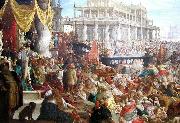
Oil On
Canvas, Real Flavor of Old Masters
|
RENI, Guido
|
|||
|
|
|||
| Italian Baroque Era Painter, 1575-1642 Italian painter, draughtsman and etcher. He was one of the greatest and most influential of the 17th-century Italian painters, whose sophisticated and complex art dominated the Bolognese school. A classicizing artist, deeply influenced by Greco-Roman art and by Raphael but also by the mannered elegance of Parmigianino's paintings, he sought an ideal beauty; his work was especially celebrated for its compositional and figural grace. In his religious art he was concerned with the expression of intense emotion, often charged with pathos; according to his biographer Malvasia, he boasted that he 'could paint heads with their eyes uplifted a hundred different ways' to give form to a state of ecstasy or divine inspiration. | |||
|
|
|||
|
|
Massacre of the Innocents new1/RENI, Guido9.jpg Painting ID:: 8872 Visit European Gallery |
1611 Oil on canvas, 268 x 170 cm Pinacoteca Nazionale, Bologna | |
Height Width |
INS/CM |
||
|
X |
|
||
|
|
|||
|
GIOTTO di Bondone
|
|||
|
|
|||
| Italian Early Renaissance Painter, 1267-1337 Italian painter and designer. In his own time and place he had an unrivalled reputation as the best painter and as an innovator, superior to all his predecessors, and he became the first post-Classical artist whose fame extended beyond his lifetime and native city. This was partly the consequence of the rich literary culture of two of the cities where he worked, Padua and Florence. Writing on art in Florence was pioneered by gifted authors and, although not quite art criticism, it involved the comparison of local artists in terms of quality. The most famous single appreciation is found in Dante's verses (Purgatory x) of 1315 or earlier. Exemplifying the transience of fame, first with poets and manuscript illuminators, Dante then remarked that the fame of Cimabue, who had supposed himself to be the leader in painting, had now been displaced by Giotto. Ironically, this text was one factor that forestalled the similar eclipse of Giotto's fame, which was clearly implied by the poet. | |||
|
|
|||
|
|
Massacre of the Innocents new21/GIOTTO di Bondone-785293.jpg Painting ID:: 62985 Visit European Gallery |
1304-06 Fresco, 200 x 185 cm Cappella Scrovegni (Arena Chapel), Padua A great number of slaughtered children lie on the ground. A soldier stands over the corpses and, at the command of King Herod (who appears in the painting himself), snatches a baby boy from his mother. The women scream, weep and try to protect their children. The men on the other side turn away, crushed and ashamed. Artist: GIOTTO di Bondone Painting Title: No. 21 Scenes from the Life of Christ: 5. Massacre of the Innocents , 1301-1350 Painting Style: Italian , , religious | |
Height Width |
INS/CM |
||
|
X |
|
||
|
|
|||
|
unknow artist
|
|||
|
|
|||
|
|
|||
|
|
Massacre of the Innocents new23/unknow artist-354673.jpg Painting ID:: 71773 Visit European Gallery |
1590 Oil on canvas 245 x 358 cm (96.46 x 140.94 in) | |
Height Width |
INS/CM |
||
|
X |
|
||
|
|
|||
|
Lucas van Valckenborch
|
|||
|
|
|||
| Flemish Northern Renaissance Painter, 1530-1597 | |||
|
|
|||
|
|
Massacre of the Innocents new26/Lucas van Valckenborch-493558.jpg Painting ID:: 96975 Visit European Gallery |
circa 1590-1595 Medium oil on copper Dimensions 41 X 59.5 cm cyf | |
Height Width |
INS/CM |
||
|
X |
|
||
|
|
|||










